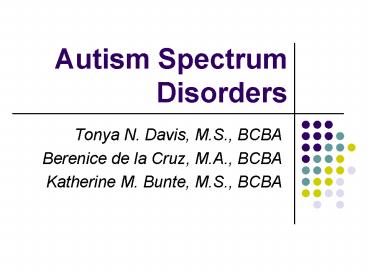Autism Spectrum Disorders - PowerPoint PPT Presentation
1 / 40
Title:
Autism Spectrum Disorders
Description:
Katherine M. Bunte, M.S., BCBA. Pervasive ... Markedly impaired expression of pleasure in other people's happiness ... Echolalia. Idiosyncratic language ... – PowerPoint PPT presentation
Number of Views:294
Avg rating:3.0/5.0
Title: Autism Spectrum Disorders
1
Autism Spectrum Disorders
- Tonya N. Davis, M.S., BCBA
- Berenice de la Cruz, M.A., BCBA
- Katherine M. Bunte, M.S., BCBA
2
Pervasive Developmental Disorders (PDD) Autism
Spectrum Disorders (ASD)
3
Autism
- Developmental Disorder
- Neurobiological Disorder
- Lifelong Disorder
4
Categories of Impairment
- Social Interaction
- Communication
- Restricted interests and stereotyped behaviors
5
Social Interaction
- Non-verbal behaviors
- Peer relationships
- Markedly impaired expression of pleasure in other
peoples happiness - Social or emotional reciprocity
6
Video Examples
- Response to name
- http//www.youtube.com/watch?vtPDOd9TM8Bc
- Lack of eye contact
- http//www.youtube.com/watch?vp3n7Pm9UkJgmodere
latedsearch - Video
7
Communication
- Delay or lack of spoken language
- Difficulty initiating or sustaining a
conversation - Stereotyped and repetitive use of language
- Echolalia
- Idiosyncratic language
- Lack of varied spontaneous make-believe play or
social imitative play
8
Video Examples
- Repetitive speech
- http//www.youtube.com/watch?vB-QzSJSNTI4
- Communication Methods
- Video
- Video
9
Repetitive and Stereotyped Behavior
- Restricted interests
- Abnormal preoccupation or intensity of interest
- Compulsive adherence to nonfunctional routines or
rituals - Stereotyped and repetitive motor mannerisms
- Preoccupation with parts of objects
10
Video Examples
- Compulsive adherence to nonfunctional routines or
rituals - http//www.youtube.com/watch?vG7kHSOgauhgmodere
latedsearch (114) - Stereotyped and repetitive motor mannerisms
- http//www.youtube.com/watch?vJnylM1hI2jc
- Video
- Preoccupation with parts of objects
- http//www.youtube.com/watch?vJ3yQHyXHmYc
11
Other
- Most individuals also have intellectual
disability - Theory of Mind
- Difficulty understanding the perspective of other
people - Challenging behavior
12
Video Examples
- Challenging Behaviors
- Video
- http//www.youtube.com/watch?vB63N1CkMr3I
13
History of Autism
- First described 60 years ago by Dr. Leo Kanner.
- Early erroneous belief that autism was caused by
poor mother-child bonding. - Autism was deemed a separate disability category
under the IDEA in 1990.
14
Cause Development
- Cause
- Unknown
- Many theories
- Developed by the childs 3rd birthday
- May be indicators
- Earlier diagnosis
15
Prevalence
- 1 in every 150 children is diagnosed with autism
spectrum disorders - Centers for Disease Control 2007
- Affects 4 times as many boys as girls.
- No differences among ethnic or racial groups
- Increased prevalence
16
Aspergers Disorder
- Characterized by
- Average to above average intelligence
- Adequate language skills in vocabulary and
grammar - Difficulty with social skills and relationships
- Restricted range of interests
- Later onset than Autism
- Difficulty understanding humor and irony
17
Social Interaction
- Non-verbal behaviors
- Peer relationships
- Markedly impaired expression of pleasure in other
peoples happiness - Social or emotional reciprocity
18
Repetitive and Stereotyped Behavior
- Restricted interests
- Abnormal preoccupation or intensity of interest
- Compulsive adherence to nonfunctional routines or
rituals - Stereotyped and repetitive motor mannerisms
- Preoccupation with parts of objects
19
Aspergers Diagnosis Criteria
- There is no clinically significant general delay
in language - There is no clinically significant delay in
- Cognitive development
- Self-help skills
- Adaptive behavior
- Curiosity about the environment in childhood
20
High Functioning Autism vs. Aspergers
- Difference in Aspergers
- Later onset
- Less severe communication and social deficits
- Higher verbal IQ than performance IQ (usually
reverse in autism)
21
Aspergers Disorder
- 36/10,000 (55/10,000 of all boys, and 15/10,000
of all girls), - 4/1 male/female ratio
- 0.7 of populations
22
Pervasive Developmental Disorder-Not Otherwise
Specified (PDD-NOS)
- Criteria of symptoms of the four specific types
of PDD are not met and/or - The degree of impairment is not present
23
PDD-NOS
- There is clinical evidence that suggest that
Autism and PDD-NOS are on a continuum (i.e., a
young child can begin with PDD-NOS, develop more
features of autism, and be re-diagnosed as having
Autism or a person with Autism can improve and be
re-diagnosed as having PDD-NOS).
24
Therapy, Treatment, and Strategies!
- Systematic, structured instruction
- Visuals
- Augmentative and Alternative Communication
- Functional approach to challenging behavior.
Behavior is communication!
25
Systematic and Structured
- The environment is arranged in a way to support
cognitive organizers. - Visual cues
- Visual organization, etc.
- Routines
- Clear expectations
- Predictability
- Procedures, curriculum, demands, etc. are
communicated by the environment
26
Physical Organization
27
Structured Workstation
28
Structured Workstation
29
Structured Workstation
30
Structured Workstation
31
Visual
- Children with ASD tend to be visual learners so
use this to your advantage!
32
(No Transcript)
33
Schedules
34
Schedule
35
Schedules
36
Augmentative and Alternative Communication (AAC)
- Pictures
- Sign Language
- Voice Output Communication Aids (VOCAS)
37
(No Transcript)
38
Functional Approach to Behavior
- Decide what the child is trying to communicate.
- Give the child a better way to communicate!
39
Applied Behavior Analysis
- Thirty years of research demonstrated the
efficacy of applied behavioral methods in
reducing inappropriate behavior and in increasing
communication, learning, and appropriate social
behavior. - Mental Health A Report of the Surgeon General
(1999)
40
References
- American Psychiatric Association. (1994).
Diagnostic and statistical manual of mental
disorders (4th ed.). Washington, DC Author. - NICHCY (2003). Pervasive developmental Disorders.
Retrieved on June 13, 2007 from
http//www.nichcy.org/pubs/factshe/fs20txt.htm - Ozbayrak, R. K. (2007). Aspergers Disorder.
Retrieved on June 13, 2007 from
http//www.aspergers.com/ - Scheuermann, B., and Webber, J. (2002). Autism
Teaching DOES make a difference. Belmont, CA
Wadsworth.































